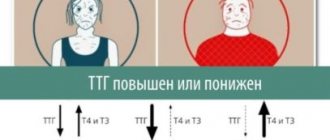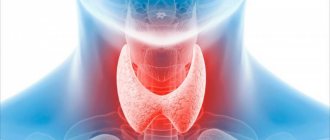The text is for informational purposes only. We strongly urge you not to use diets, resort to any therapeutic menus or fasting without medical supervision. We recommend reading: “Why you can’t go on a diet on your own.”
Hypothyroidism is a pathology of thyroid function in which the production of thyroid hormones is disrupted.
To maintain normal hormone levels, specialists prescribe a strict regimen of hormone replacement medications. However, a diet for hypothyroidism is very important, since it can provide the sick person’s body with iodine and other substances it lacks, and also affects the overcoming of hypothyroidism symptoms such as brittle nails, dry skin, dehydration, and changes in body weight. These problems can be easily corrected by selecting a menu appropriate to the state of health and the prescribed therapy.
The principle of choosing foods and building diets
Content:
- The principle of choosing foods and building diets
- Diet for a week
- Diet Mary Chaumont
- How to lose weight with hypothyroidism
- Nutrition after surgery
When treating hypothyroidism, diets are chosen according to such principles that they help resolve issues of normalizing tissue circulation, metabolic processes, healthy weight, and also prevent the development of atherosclerotic changes.
The caloric content of the diet of a patient with this pathology should not exceed 2300 kilocalories per day for men and women and be slightly less for children. At the same time, it is important to reduce the amount of difficult-to-digest foods, foods containing cholesterol and saturated fats. The daily intake of fat for hypothyroidism is a dose of 70 grams, of which 20 grams should be vegetable. The amount of carbohydrates per day should be limited to 400 grams, of which sugar can account for up to 50 grams. Proteins should be consumed up to 80 grams in the proportion - half plant, half animal.
Important rules when selecting foods for a diet for hypothyroidism are the need to replace meat with fish, seafood, consume fresh vegetables and fruits, and replace sweets with dried fruits. It is necessary to arrange a fasting day every week to give the body the opportunity to cleanse and recover.
It is necessary to prepare food while following a diet by baking it under a lid or boiling it in a double boiler. To enhance the flavor of cooked foods, it is often recommended to use iodized salt, and fats and oils should be reduced as much as possible during cooking.
Food should be eaten warm, chewing all ingredients thoroughly to reduce the load on the digestive tract. It is recommended to split meals into 5-6 small meals a day; select foods that are extremely light but rich in nutrients.
Nutritionists recommend for hypothyroidism nutrition according to the “Table No. 8” or “Table No. 15” system. The menu of these diets is diverse, nutritious, healthy and very tasty. It contains all the minerals the body needs to maintain the thyroid gland in optimal condition.
Healthy foods
The basis of the diet of children and adults with pathologies of the thyroid gland should be the products presented in the table:
Healthy foods recommended for hypothyroidism
| Name of product (product group) | Description of useful substances and positive effects on the body in case of hypothyroidism |
| Fish, any seafood | They are a source of essential iodine and many minerals that are part of thyroid hormones. Required for patients with hypothyroidism on an ongoing basis in sufficient quantities. Locally caught seafood that has not been frozen or transported has the best quality. If you have hypothyroidism, you should try to eat lean fish every day. |
| Algae, seaweed | Seaweed is the richest source of selenium, phosphorus and iodine for the thyroid gland. A salad prepared with seaweed or Japanese cuisine, which has become so popular lately in European latitudes, is perfect. |
| Fruits | Necessary for normalizing metabolic processes in hypothyroidism. Any fruit that is not very sweet can be consumed in sufficient quantities, but it is healthier to eat those that contain more iodine - feijoa, persimmon, kiwi. If the patient wants to arrange a fasting day, then apples are ideal for this, the iodine content in which perfectly covers the body’s daily needs. An excellent combination is a fruit mixture with fiber, for example, with all kinds of seeds. |
| Greens, vegetables | If you have hypothyroidism, it is not recommended to eat only cruciferous vegetables; the body needs all the rest in large quantities. The most iodine is found in beets and tomatoes. But the necessary vitamin A for the thyroid gland can be supplied by orange and red foods. Carrots, cucumbers, spinach, green salad and any kind of greens are healthy. It is recommended to eat a lot of vegetables if the patient eats meat, as they contribute to the production of B vitamins, which are needed to improve suffering cognitive processes. |
| Various cereals | Millet, buckwheat, barley groats and porridges made from them provide the body with various vitamins and also help increase the productivity of the thyroid gland. |
| Dairy | Milk and all milk-based products for hypothyroidism should be low-fat or contain a minimum percentage of fat. An excellent milk-based product for this disease is hard, low-fat cheese, which contains a high percentage of iodine. |
| Dried fruits, nuts, spices | Dried fruits and nuts are a storehouse of valuable minerals and iodine, so you can safely include them in your diet if you have thyroid problems. The best in the business are pine nuts and walnuts, as well as dried apricots. Among the various spices that are recommended to be added to food for this pathology, turmeric comes first, as it has the ability to purify the blood. |
| Berries | It is useful to eat unsweetened berries, especially cherries, currants and gooseberries, which not only contain a rich supply of iodine, but also many other vitamins. |
| Beverages | Most of all, you need to drink non-carbonated filtered clean water in an amount of at least one and a half liters per day. Other drinks include weak tea, sugar-free compotes, and freshly squeezed juices. |
Harmful products
The list of prohibited or undesirable foods for consumption by patients with hypothyroidism is also quite wide.
You can find out more about them in the table: Prohibited foods for hypothyroidism
| Name of product (product group) | Description of the negative effects on the body with hypothyroidism |
| Very sweet fruits and berries, any sweets (baked goods, baked goods) | It is undesirable to consume watermelons, bananas, figs, and grapes in large quantities, since these products contain very high sugar content, which leads to a slowdown in metabolism in the body and inhibition of hormone production. The same goes for buns, chocolate, honey. |
| Cruciferous vegetables | Broccoli, cabbage, cauliflower, mustard, turnip, kohlrabi, rutabaga, due to the content of isothiocyanates, block the enzyme peroxidase of the thyroid gland and its cell membranes, which leads to a decrease in the functionality of the gland and inhibition of hormone production. |
| Legumes | Beans and soy contain a large amount of isoflavones, which inhibit the activity of the thyroid peroxidase enzyme. |
| Alcohol | Promotes the consumption of a huge number of hormones T3 and T4 during their absorption. The lack of such hormones in the body gives rise to hypothyroidism. |
| Products with poisons and dyes | Sausages, smoked meats, canned food, mayonnaise, soda, as well as non-organically grown meat, poultry, eggs and dairy products can stimulate the thyroid gland to grow, which should not be allowed. |
Dangerous problems
COVID on the neck: new coronavirus provokes thyroid diseases
Hormonal disorders can be both inflammatory and autoimmune in nature, scientists say
In the world, over 665 million people have endemic goiter or suffer from other thyroid pathologies, 1.5 billion people face the risk of developing iodine deficiency diseases. According to WHO statistics, the increase in the number of thyroid diseases on the planet is approximately 5% annually. Decreased thyroid function develops in 2–3% of Russians in general and 8–9% of people over 60 years of age; unsafe nodules are detected by modern methods in almost 30% of adults. It is important to keep in mind that goiter - an increase in the size of the thyroid gland in regions of iodine deficiency, which our country belongs to - occurs in 12-30% of the population.
The thyroid gland produces hormones that regulate metabolism and affect all aspects of a person’s life, including even mood and appearance. Another important function of hormones is to constantly maintain body temperature and produce energy. For a deeper understanding of the principles of the functionality of the thyroid gland, you need to remember two words: “information” and “adaptation”. Hormones are carriers of information. Information exchange in the body occurs not only with the help of nerve impulses. Biochemical compounds - hormones - spread through the bloodstream to all organs and tissues and affect receptors (sensors) on the surface of cells. This way, each cell receives a signal about how intensely it needs to work.
Safe conduct3
Photo: RIA Novosti/Anton Denisov
Voice prosthesis: a new device will save speech after removal of a tumor on the thyroid gland
An implant with electrical stimulation function is primarily necessary for patients with cancer
“Thyroid diseases can be a consequence of autoimmune, inflammatory, tumor processes, exposure to drugs, harmful environmental factors,” says Marina Vershinina, leading expert at the Center for Molecular Diagnostics CMD Central Research Institute of Epidemiology of Rospotrebnadzor. - Depending on the pathological mechanism, the function of the thyroid gland can be excessively enhanced (hyperthyroidism) or weakened (hypothyroidism).
With hyperthyroidism, people complain of increased emotionality, anxiety, frequent mood swings, irritability, and tearfulness. The heartbeat accelerates, there is rapid fatigue, excessive sweating, tremors (shaking throughout the body), frequent bowel movements, a significant decrease in body weight with increased appetite, and body temperature rises.
Research Top Achievements of the Year: 3D Printing of Living Tissues and Purple Wheat
Discoveries by Russian researchers can change our lives
With hypothyroidism, on the contrary, there is general weakness, decreased appetite (with an increase in body weight), drowsiness, memory impairment, and weakened intellectual abilities. Metabolic processes slow down: the pulse becomes rare, swelling appears, body temperature and blood pressure drop, and intestinal motility slows down. Women often have irregular menstrual cycles, and men have problems with potency.
Thyroid dysfunction in children can lead to catastrophic consequences. The key features of a child’s body are growth, development and maturation of structures, notes Dr. Vershinina. Due to an insufficient amount of thyroid hormones, these processes are fatally disrupted. Hypothyroidism in children leads to a pronounced lag in physical and neuropsychic development, which can no longer be corrected. While it’s easier for adults, it’s a disaster for children.
Safeguard 2
Photo: IZVESTIA/Konstantin Kokoshkin
Diet for a week
With hypothyroidism, it is allowed to eat most tasty and varied foods, so a diet for a patient for a week can be easily compiled. Every day the patient will eat the right healthy food, and if some foods do not suit his personal preferences, they can always be replaced with others. A sample weekly menu for patients with hypothyroidism might look like this:
- Monday. For breakfast, the patient is asked to eat muesli with skim milk, drink tea with stevia instead of sugar, and eat a sandwich of whole grain bread and low-fat cheese. For lunch you can offer a carrot salad, low-fat borscht cooked with veal, a glass of tea with a small slice of dark chocolate. Nuts or berries from the list of permitted ones are perfect as a snack. For dinner, the patient can be offered baked chicken or fish, and for dessert - baked pumpkin or apple.
- Tuesday. For breakfast, low-fat cottage cheese or a couple of chicken eggs with a salad of herbs and cucumbers, plus a sandwich with cheese, as on the previous day, are suitable. You can wash down your breakfast with kefir or yogurt. For lunch, it is suggested to eat stewed chicken or turkey with mashed potatoes and cucumber-tomato salad. Any acceptable fruit is offered for a snack. As a snack, the patient can eat boiled seafood or a sandwich made from whole grain bread and lean ham. For dinner there is a choice of cottage cheese or beef stroganoff, tea, bread and butter and 1 piece of fruit allowed.
- Wednesday. For breakfast, cottage cheese with nuts, whole grain bread with butter and kefir are served. For lunch, you can choose from boiled chicken or vegetable soup with lean meat, as well as kefir or tea with dark chocolate. As a snack, you can eat any low-fat dessert, fruit or sandwich. Dinner will require steamed fish with a side dish of wild rice, as well as freshly squeezed juice.
- Thursday. For breakfast, the patient should be offered 2 boiled farm eggs, seaweed salad and kefir or low-fat milk. For lunch, prepare a low-fat broth with chicken and eggs, herbs and carrot salad. You should wash down your lunch with green tea with stevia. For a snack, kiwi, nuts or a low-fat dessert are perfect. For dinner on Thursday you can have boiled chicken with a vegetable side dish or salad.
- Friday. For breakfast, you need to boil sea fish and serve it with a sandwich of whole grain bread, butter and low-fat cheese. You can wash it all down with freshly squeezed juice. For lunch, you need to eat boiled chicken with a vegetable salad or vegetable side dish, and choose an avocado for a snack. For dinner, a seaweed salad with stewed beef, washed down with tea and dark chocolate, would be good.
- Saturday. For breakfast, it is recommended to bake tomatoes with cheese and boil a couple of eggs, and you can wash it all down with juice, kefir or tea. The patient should have lunch with lentil soup, salad with apple and spinach. Fully low-fat fruit curd is suitable as a snack. For dinner on Saturday, you can cook any lean grilled meat, Korean salad and bake the permitted vegetables.
- Sunday. For breakfast, an omelet with Adyghe cheese and jelly is served. For lunch, try veal steak, vegetable salad or steamed vegetables. Pumpkin seeds or nuts are great snacks. For dinner, it is recommended to prepare mashed potatoes with herring or serve cottage cheese; you can wash down dinner with juice or tea with stevia.
It is important to remember that you can do a fasting day once a week. If the patient does not eat meat, then all meat products on the menu can be replaced with green buckwheat and tofu.
Diet Mary Chaumont
Mary Chaumont is a famous American writer who was once diagnosed with hypothyroidism, but she did not lose heart and developed a special diet to maintain normal weight in conditions of a slow metabolism. Her diet does not restrict calories too much. To calculate daily caloric intake, you need to apply the formula: multiply your own weight by 25 and subtract 200 from the resulting number. For example, with a weight of 60 kilograms, a person needs to consume 60 * 25 = 1500-200 = 1300 kilocalories per day, which is not too little. In this case, each meal should be 1/6 of the daily calorie intake, that is, in the above example, about 217 kilocalories.
You can eat all the foods that were listed as allowed above, but the main emphasis in this diet is recommended to be on dishes with tyrosine, such as lean poultry, fish, and dairy products with a minimum of fat. Almonds, pumpkin seeds, avocados and lentils also contain this component in abundance. In addition to tyrosine, you should not forget about other micro- and macroelements that are important to get from cereals. Food can only be salted with iodized salt. To replenish the vitamin complex according to the Mary Chaumont diet, vegetables and fruits are needed.
The daily menu from Mary Chaumont may look like this. For breakfast, it is recommended to eat a choice of steamed omelet, vegetable stew, vegetable puree or salad, as well as liquid milk porridge. For lunch, Mary Chaumont offers low-fat cottage cheese with permitted berries, jelly or jelly. For lunch you should prepare low-fat fish soup, light soup, steamed cutlets or fish or chicken soufflé. Berry or fruit mousse, low-fat yogurt or baked apple are suitable as a snack. For dinner, the American writer suggests choosing baked fish with salad or vegetable puree, pumpkin porridge and baked vegetables.
How to lose weight with hypothyroidism
With hypothyroidism, weight loss should be aimed not so much at losing extra pounds, but at normalizing metabolism, which is the cause of obesity.
To lose weight with hypothyroidism, you need to eat small meals often, not overeat and not make your body feel very hungry. Severe hunger, in addition to slowing down the already disturbed metabolism, provokes depression. In order for the menu to be complete in terms of useful components, you should pay more attention to fresh fruits, vegetables, and herbs, which are rich in thyroid-regenerating components and vitamins. In addition to following a diet, it is important to lead a healthy lifestyle - do not forget about adequate physical activity, and walk a lot in the fresh air. To maintain the thyroid gland and stabilize metabolic processes, you need to eat a lot of iodine-containing foods, such as seafood, seaweed, and other algae. But you should completely avoid foods that cause obesity and slow metabolism. Such foods include sweet, salty and alcohol.
Safety regulations
Master of iodine: a new form of dietary supplement will not evaporate from salt
Scientists have proposed an alternative method to prevent deficiency of an important nutrient for health
At any age, it will be useful to prevent thyroid diseases: ensuring sufficient iodine intake in the body, using iodized salt when preparing food, a healthy lifestyle, reducing stress, living in environmentally friendly conditions.
This is especially important for those whose relatives have thyroid diseases.
For elderly and elderly people, in addition to the above, it is important to undergo regular laboratory examinations. In patients of the older age group, the symptoms of both hyper- and hypothyroidism are often erased and unexpressed. They are often masked behind signs of natural aging of the body and the decline of cognitive abilities.
It would also be a good idea to undergo an ultrasound examination and a thyroid-stimulating hormone (TSH) test every 1-3 years.
Hungry time: why it’s better not to deny yourself food
Dietary restrictions can affect not only the health of the person losing weight, but also the life expectancy of his offspring.










